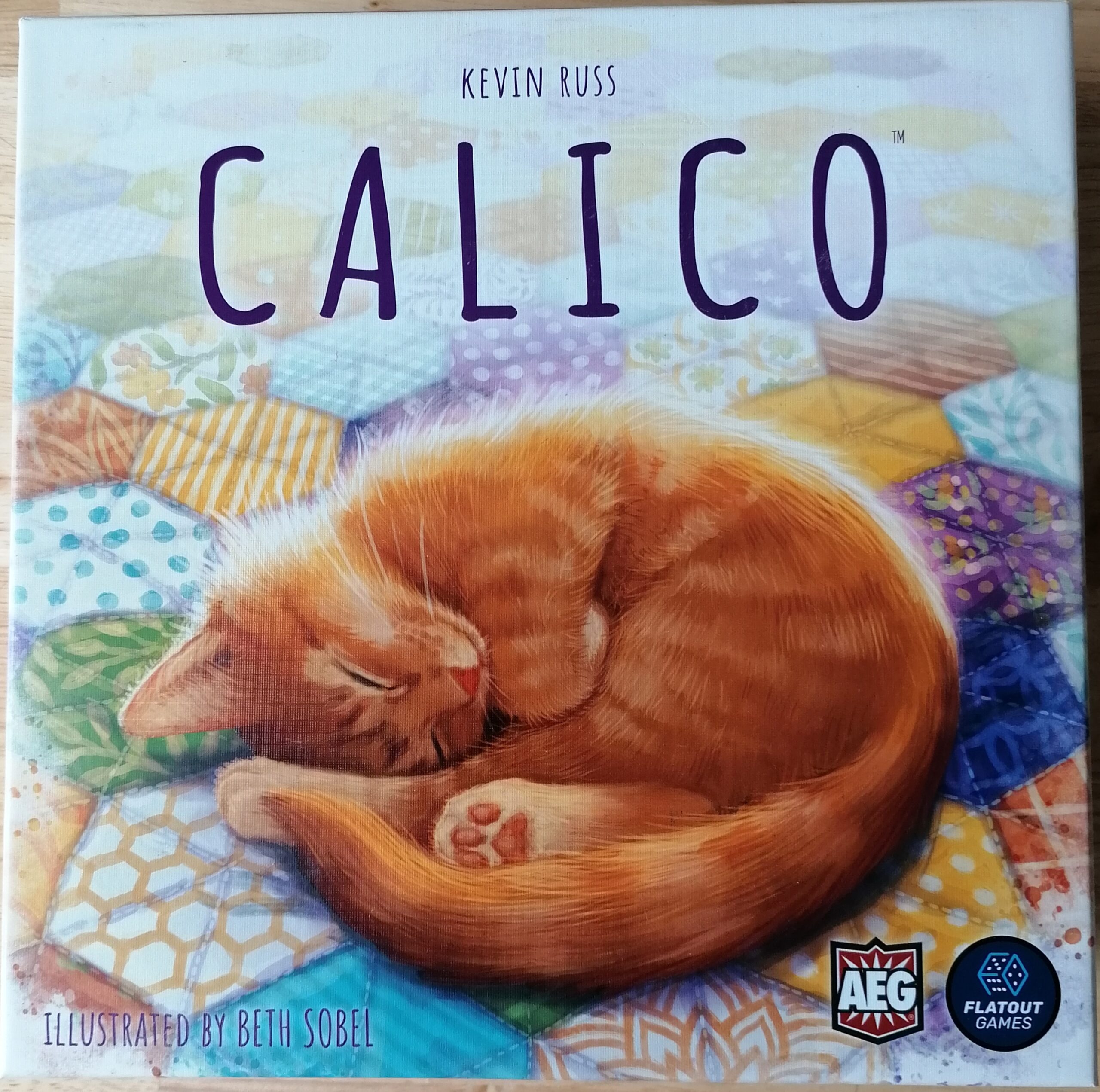When I first saw Calico, I thought ‘wow, that looks like such a nice, relaxing game’. I mean, look at the cover. A cat sleeping on brightly coloured hexes. And then I heard about what the game was about. Building a quilt using lots of vibrantly coloured, beautifully patterned tiles, trying to attract cats to come and lie on it. If that doesn’t scream relaxation I don’t know what does.
But then I looked further into how the game plays, and I kept hearing people say that it was quite the opposite; a fairly intricate puzzle with very tough decisions. For me, this wasn’t a problem, I like games that burn my brain a little, I only say this so that you’re not coming into this one with the wrong impression. Calico, contrary to its physical presentation, is not a nice, relaxing game.
Calico begins
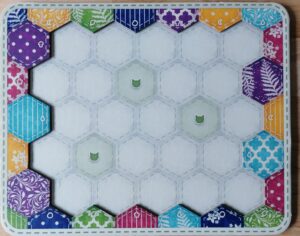
At the beginning of the game, each player receives a player board, a set of objective tiles and two tiles are drawn randomly from a bag, which will be your starting hand. Each turn you will be placing one tile from your hand anywhere onto your board, taking a new tile from the market and then play moves to the next player. And that’s it, on the face of it. It all comes down to what you place where though.
There are two restrictions in Calico that really make this game; the limit of two tiles in your hand, and the fact that you only have three tiles to choose one from. Without these, this game would probably play like its calming presence would suggest, but at the same time, for me anyway, that would take away a lot of what makes this game great. Every turn, you’ll have a plethora of thoughts swimming through your head. Which of these two tiles is best to place now? Where’s the best spot in which to place it? Of the three tiles available, what’s the best one I could take at this moment?
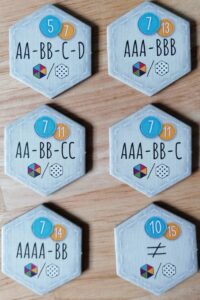
The objectives present probably the largest challenge to the players. On your first game of Calico, the rulebook suggests that all players start with the same three beginner objectives, just so that you can all get used to how they work, and I would probably recommend this too. Each player places one objective on each of the hexes with cat symbols showing at the start of the game, and these will be where you’ll get a lot of your points. Objective tiles are made up of two parts: the points and the requirement. The letters/symbol in the middle of the tile represents the requirements for the tiles you place to surround the objective tiles. Five of the six objectives follow the same formula; you need to have a certain amount of tiles that are the same, either by colour, pattern or both, equal to the letters on the tiles. For example, with the objective that reads ‘AA-BB-CC’, you need three sets of two tiles that match in at least one way. The ‘AA-BB-C-D’ tile requires you to have two sets of two that match, and then two tiles that are different to all the others. The only objective that doesn’t follow this formula is the one in the bottom right of the picture, showing that no surrounding tiles can match, in at least one way.
The second part which makes up these tiles are the points, shown in the buttons at the top of the tile. The lower number in the blue button means that, if you meet these conditions in only one way i.e. by colour or pattern, you’ll get that amount of points for that objective. Also, if you’re going to score like this, your surrounding tiles must meet the criteria, in the same way, meaning that, as an example, you can’t have two matching by colour, then two matching by pattern. The higher number, shown in the gold button, is the number of points you receive if you fulfil the conditions both in colour and pattern. This is a fair bit more difficult to pull off in Calico, which is why it’s worth more points, but you need to be careful. As the objectives are all quite close to each other, tiles placed next to one objective may well also affect another objective, and it’s possible that a tile placed to help one objective may ruin your chances of getting another. In my first game of Calico, I was guilty of being too greedy. I tried to achieve the higher points value on at least two of my objectives, and in doing so, failed two completely, because of how I’d placed my other tiles.

Objectives are not the only way to score points in Calico though. As I mentioned at the start, you’re trying to entice cats into coming and lying on your quilt. Three cats will be in play each game, all of which are attracted to two different patterns each (a nice thematic touch, as though not completely colour blind, cats don’t see colours as we do), and all come with requirements for how the patterns need to be laid out on your board. Again, the rulebook suggests three starting cats for your first game, as these have the easiest requirements (though I have played with them in all my games so far, as there’s always been at least one new player in each game). I’m a big fan of the fact that the developers and designers have done as much as they can to make this an accessible game. In giving these starting suggestions, they give players a nice way in, whilst not limiting a player who may want to start off in the deep end.
In Calico each time a player completes a certain requirement on a cat, they take one of the related cat tokens and place it on their board, on one of the tiles which helped fulfil the prerequisite. As an example, Millie, the cat on the left of the picture above, wants a group of three (she doesn’t care what shape the group of three takes) of the specified patterns, and for every Millie cat token you have on your board at the end of the game, you will gain three points. One thing players will need to keep in mind is that once you’ve placed a cat, if you want to make another grouping for the same cat, it has to be completely separate, giving you something else to think about.
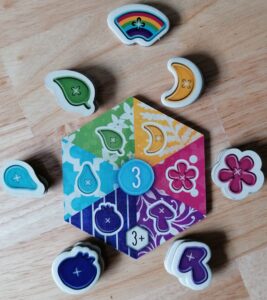
As there’s a way to score with the patterns, of course, there had to be a way to score based on the colours of the tiles. In Calico If you manage to place a group of three tiles of the same colour (any shaped group), you earn a button of that colour, which are all worth three points. As with the cats, you’re not limited in the amount of the same button you can place, but it may be worthwhile trying to diversify, not only because it’s very likely that you’re not going be able to keep drawing the same-coloured tiles, but also because if you manage to get one of each colour, you gain a rainbow button. Again, this is only worth three points, but it’s essentially free. The rule of the separate groupings is the same here as with the cats, and in both cases, I think it’s a necessary rule, to keep you from just placing the same tiles next to each other all game.
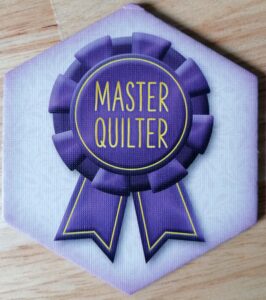
Something in Calico that is a big help with both the cat scoring and the button scoring is the boards themselves. They all have pre-printed hexes around the edges, matching the colours and patterns of the in-game tiles. The rules state that these can be used as part of a grouping to score these two things, and for me, this is a very good addition for a few reasons. Apart from the fact that it looks good, it also makes it slightly easier to get the groupings you need, and given that you only have two tiles in your hand, it feels needed. Also, it gives you an idea of where to start, and what to aim for. Because you can place a tile anywhere, you may feel a little lost as to where to start if these weren’t present, so having these lets you survey your board and plan ahead. Again, you may just want to concentrate on the objectives, and given that you could potentially get a lot of points this way, it may be best, but don’t underestimate these other two ways of scoring.
In terms of production, Calico is fantastic. The tiles are nice and thick, colourful, and well-distinguished by their patterns. The cat tokens are lovely to have (they could have easily just been coloured cubes or generic cardboard tokens with the cat’s name on them), and are even more pleasing sitting on your board. The tile bag is lovely and big, the player boards are wonderful, dual-layered, and the tiles fit so nicely that once you’re finished you can lift it up like a picture. The winner even gets a large cardboard token to commemorate their victory.
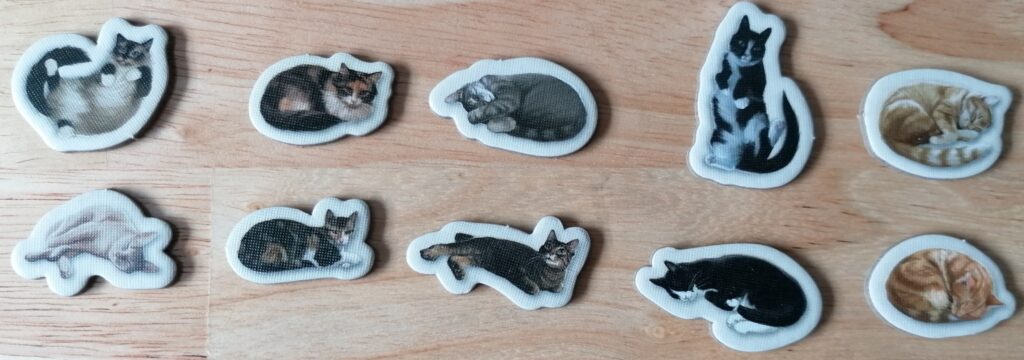
Calico In Summary
As I said at the beginning of this review, there’s the potential for Calico to mislead people, which may disappoint some. If someone sees this and thinks what I thought about Calico initially, without delving deeper, they may not get what they wanted. On the other hand, a game that looks this good, with a rare, if ever, used theme, which is appealing to many, has the potential to attract lots of new players to this hobby. Once you get into Calico, if you love a tile-laying game that, on the surface, is very simple, but which gives you very crunchy decisions and tight restrictions, then this is one for you. I certainly don’t regret purchasing Calico, and I’m happy to keep it in my collection.
| Prices delivered by BoardGamePrices | |
|---|---|
 | Calico £36.29 with shipping, in stock! Buy now See all 48 offers! |

